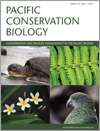
Pacific Conservation Biology
Volume 25 Number 4 2019
Animal responses to restoration are often overlooked in assessments of mine site restoration success. We identify and address potential biases or shortcomings relating to fauna responses and emphasise the need for global reevaluation of regulatory standards to allow the mining industry to comprehensively and representatively restore faunal communities after mining.
PC18079 Abstract | PC18079 Full Text | PC18079PDF (302 KB) | PC18079Supplementary Material (560 KB) Open Access Article
Research on citizen science is becoming increasingly important for identifying needs and recommending options to support this fast-growing field. The perspective offered here is that reducing barriers to participation is the surest way to maintain citizen science momentum, and that this will be assisted by a comprehensive understanding of diversity in the motivations for citizen science on the ground.
Our knowledge of the impacts of climate change on biodiversity is strongly skewed. Northern Hemisphere and temperate system bias dominate understanding of phenology. Conservation plans that do not consider phenological changes may be ineffective.
PC18052How an Indigenous community responded to the incursion and spread of myrtle rust (Austropuccinia psidii) that threatens culturally significant plant species – a case study from New Zealand
 , Melanie Mark-Shadbolt
, Melanie Mark-Shadbolt  , Gary Garner, Jenny Green, Tame Malcolm, Alby Marsh, Hone Ropata, Nick Waipara and Waitangi Wood
, Gary Garner, Jenny Green, Tame Malcolm, Alby Marsh, Hone Ropata, Nick Waipara and Waitangi Wood
Myrtle rust was confirmed in May 2017 in New Zealand and has spread throughout the country. It has been detected on a range of Myrtle plant species with many of these iconic to Indigenous Māori. We describe the journey of an Indigenous community approach to a modern biosecurity incursion.
This essay discusses two waves of settlement by Homo sapiens of continental Australia; the first over 60 000 years ago, and the second less than 250 years ago. The failure of the second wave of Homo sapiens to understand the way the first wave had changed the biotic composition has led to major environmental problems.
With shifting baseline syndrome affecting marine ecosystems globally, conservationists seek new strategies to effectively protect ecosystems while appealing to third parties in government and trade. Ecosystem-based-tourism has often been framed as an economically sound method of enforcing conservation regulations while educating laymen on important ecological topics. Shark-based tourism is one such example that facilitates up-close interactions with charismatic marine species and often promotes conservation efforts. This study aims to investigate ecosystem-wide implications of shark-based tourism in Fijian coral reefs.
PC18082Spatial and temporal patterns of reptile roadkill in the north-west Australian tropics
During eight months of surveying 31 km of highway in Broome, Western Australia, we found a relatively low 44 examples of roadkill, most of it varanids. Roadkill was higher in the wet season despite a decrease in traffic intensity. Carcass persistence experiments using fake roadkill (sausage meat) of different sizes, however, indicated that roadkill surveys probably highly underestimate the effects of roads on reptiles due to an extremely high rate of carcass removal.
PC18081Agriculture, brolgas and Australian sarus cranes on the Atherton Tablelands, Australia
Brolgas and Australian sarus cranes forage amongst crops on the Atherton Tablelands. We found that they concentrated on cereals and peanuts and that brolgas tend to forage on fields close to their roosts. Global agronomic trends may reduce foraging opportunities and increase the potential for damage and conflict with farmers.
PC18057Achieving forest conservation in Fiji through payment for ecosystem services schemes
Forest payment for ecosystem services schemes to deliver both ecological and socioeconomic outcomes for local communities are being applied in Fiji, and have potential for replication to other priority forest areas in Fiji to meet Fiji’s obligations under the Convention on Biological Diversity, but at an estimated financial cost of US$69.0–287.8 million.
We conducted intensive camera trapping from 29 May 2015 to 30 June 2016 (397 calendar days) to investigate broad-scale recruitment success, behaviour and potential threats to recently translocated population of the island Endangered endemic Cocos buff-banded rail. The conservation of island rallid species poses a high risk with the growing trend in the dispersal of invasive mammalian species.
PC18069Age, growth and maturity of the Australian blackspot shark (Carcharhinus coatesi) in the Gulf of Papua
 , Jonathan J. Smart, Michael I. Grant, Andrew Chin
, Jonathan J. Smart, Michael I. Grant, Andrew Chin  , William T. White and Colin A. Simpfendorfer
, William T. White and Colin A. Simpfendorfer
This study addresses the need for region-specific life-history data to improve fisheries management. The Australian blackspot shark is commonly caught as by-catch in the Gulf of Papua prawn trawl fishery. We found that this shark species is relatively fast growing and reaches maturity at approximately five years of age in this region of Papua New Guinea.
PC18089A snapshot of changes in graziers’ management and attitudes towards dingoes over 60 years
We repeated a survey conducted in the 1950s on Australian graziers’ interactions with dingoes. On the 23 properties where both surveys were completed, lethal control remained dominant, but diversification in management and attitudes was apparent in 2018. We discuss the future of dingo management amid changing narratives surrounding predators globally.
Barramundi (Lates calcarifer) often migrate from marine to fresh water as juveniles. In March 2018 a relatively large number of small juveniles (<100 mm) were recorded moving through a fishway on a tidal interface barrier in central Queensland, Australia. This is in contrast to the few documented observations of transitional movements, which involved mostly larger juveniles (250–400 mm).
We used camera traps to identify invasive Rattus rattus as predators at a green sea turtle, Chelonia mydas, nest in French Polynesia. The footage shows that the hatchlings are a familiar food source for rats and that the control of invasive rats has to be considered for the protection of endangered green sea turtles.



